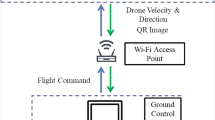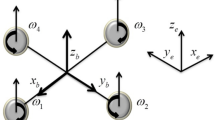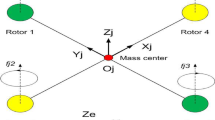Abstract
This paper proposes a solution to the external disturbance, uncertain aerodynamic parameters and inter formation collision in coordinated flight of leader-follower quadrotor UAV formation. We present a trajectory tracking control method for UAV formation with preset performance function constraints. We first model the quadrotor UAV system with a dual closed-loop system with position outer loop and attitude inner loop. The performance constraint function transforms the output constraint problem into an unconstrained problem through error transformation. We show that the uncertain aerodynamic parameters and the external disturbance can be estimated by proper design of an exponential disturbance observer. To solve the trajectory tracking problem of the Leader UAV, we introduce a backstepping adaptive control (BC) based on the preset performance. Furthermore, to overcome the issue of the collision between aircrafts in the formation flying, the formation sliding mode control (SMC) based on the power approach rate is proposed. Such a mechanism ensures that the UAVs track their respective reference trajectories quickly, so as to achieve the desired formation. The effectiveness of the control strategy is investigated by simulation. In addition, the open-source autopilot as well as the formation control airborne computer, wireless communication links and used data packet structure are presented, and the designed control law is transplanted into the Pixhawk flight control processor. The feasibility of the control strategy is demonstrated by the quadrotor UAV formation experimental platform based on the Robot Operating System (ROS).
Similar content being viewed by others
References
G. E. Moore, “Cramming more Components onto integrated circuits,” Proceedings of the IEEE, vol. 86, no. 1, pp. 56–59, 1998.
M. Fu, “Exploring preferences for transportation modes in an urban air mobility environment: A Munich case study,” Transportation Research Record, vol. 2673, no. 10, pp. 427–442, 2019.
Z. X. Liu, X. Yu, C. Yuan, and Y. M. Zhang, “Leader-follower formation control of unmanned aerial vehicles with fault tolerant and collision avoidance capabilities,” Proc. of International Conference on Unmanned Aircraft Systems (ICUAS), pp. 1025–1030, 2015.
W. Zhu, D. Wang, and Q. Zhou, “Leader-following consensus of multi-agent systems via adaptive event-based control,” Journal of Systems Science & Complexity, vol. 32, no. 3, pp. 846–856, 2019.
Z. Jia, L. Wang, J. Yu, and X. Ai, “Distributed adaptive neural networks leader-following formation control for quadrotors with directed switching topologies,” ISA Transactions, vol. 93, pp. 93–107, 2019.
J. Chen and J. Li, “Fuzzy adaptive leader-following consensus of second-order multiagent systems with imprecise communication topology structure,” International Journal of Adaptive Control and Signal Processing, vol. 32, no. 6, pp. 937–949, 2018.
Z. Sun, G. Zhang, Y. Lu, and W. Zhang, “Leader-follower formation control of underactuated surface vehicles based on sliding mode control and parameter estimation,” ISA Transactions, vol. 72, pp. 15–24, 2018.
X. Wang, L. Shen, Z. Liu, S. Zhao, Y. Cong, Z. Li, S. Jia, H. Chen, Y. Yu, Y. Chang, and Y. Wang, “Coordinated flight Control of miniature fixed-wing UAV swarms: Methods and experiments,” Science in China Series F: Information Sciences, vol. 62, no. 11, p. 212204, 2019.
X. Lu, S. Chen, and F. Austin, “Formation control for second-order multi-agent systems with time-varying delays under directed topology,” Communications in Nonlinear Science and Numerical Simulation, vol. 17, no. 3, pp. 1382–1391, 2012.
J. Dong, H. T. Chen, and S. Liu, “A behavior-based policy for multirobot formation control,” Applied Mechanics and Materials, pp. 1181–1185, 2012.
H. Du, W. Zhu, G. Wen, Z. Duan, and J. Lü, “Distributed formation control of multiple quadrotor aircraft based on nonsmooth consensus algorithms,” IEEE Transactions on Systems, Man, and Cybernetics, vol. 49, no. 1, pp. 342–353, 2019.
Y. Gu, B. Seanor, G. Campe, M. R. Napolitano, L. Rowe, S. Gururajan, and S. Wan, “Design and flight testing evaluation of formation control laws,” IEEE Transactions on Control Systems and Technology, vol. 14, no. 6, pp. 1105–1112, 2006.
Y. Cong, H. Du, Q. Jin, W. Zhu, and X. Lin, “Formation control for multiquadrotor aircraft: Connectivity preserving and collision avoidance,” International Journal of Robust and Nonlinear Control, vol. 30, no. 6, pp. 2352–2366, 2020.
W. Yu, H. Wang, F. Cheng, X. Yu, and G. Wen, “Second-order consensus in multiagent systems via distributed sliding mode control,” IEEE Transactions on Systems, Man, and Cybernetics, vol. 47, no. 8, pp. 1872–1881, 2017.
Z. Gosiewski and L. Ambroziak. “UAV autonomous formation flight experiment with virtual leader control structure,” Solid State Phenomena, vol. 198, pp. 254–259, 2013.
C. M. Rice, Control Design and Performance Analysis for Autonomous Formation Flight Experiments, Ph.D. Dissertation, West Virginia University, 2015.
D. Luo, T. Zhou, and S. Wu, “Obstacle avoidance and formation regrouping strategy and control for UAV formation flight,” Proc. of 10th IEEE International Conference on Control and Automation (ICCA), pp. 1921–1926, 2013.
K. Máthé and L. Buşoniu, “Vision and control for UAVs: A survey of general methods and of inexpensive platforms for infrastructure inspection,” Sensors, vol. 15, no. 7, pp. 14887–14916, 2015.
D. Shi, X. Dai, X. Zhang, and Q. Quan, “A practical performance evaluation method for electric multicopters,” IEEE-ASME Transactions on Mechatronics, vol. 22, no. 3, pp. 1337–1348, 2017.
C. P. Bechlioulis and G. A. Rovithakis, “Briefpaper: Adaptive control with guaranteed transient and steady state tracking error bounds for strict feedback systems,” Automatica, vol. 45, no. 2, pp. 532–538, 2009.
Y. Li, C. Wang, and Q. Hu, “Adaptive control with prescribed tracking performance for hypersonic flight vehicles in the presence of unknown elevator faults,” International Journal of Control, vol. 92, no. 7, pp. 1682–1691, 2019.
Y. Zhang, W. Wu, J. Wang, and L. Gao, “Prescribed performance adaptive constrained backstepping controller for carrier-based longitudinal landing with magnitude constraints,” Proc. of 36th Chinese Control Conference (CCC), pp. 856–861, 2017.
C. Zhang, G. Ma, Y. Sun, and C. Li, “Observer-based prescribed performance attitude control for flexible spacecraft with actuator saturation,” ISA Transactions, vol. 89, pp. 84–95, 2019.
M. Liu, X. Shao, and G. Ma, “Appointed-time fault-tolerant attitude tracking control of spacecraft with doublelevel guaranteed performance bounds,” Aerospace Science and Technology, vol. 92, pp. 337–346, 2019.
L. Zhou, J. Zhang, H. Dou, and B. Wen, “A fuzzy adaptive backstepping control based on mass observer for trajectory tracking of a quadrotor UAV,” International Journal of Adaptive Control and Signal Processing, vol. 32, no. 12, pp. 1675–1693, 2018.
Z. Wang and Z. Wu, “Nonlinear attitude control scheme with disturbance observer for flexible spacecrafts,” Nonlinear Dynamics, vol. 81, no. 1, pp. 257–264, 2015.
J. Liu, “Sliding mode control of a class of underactuated systems,” Sliding Mode Control Using MATLAB, pp. 261–305, 2017.
E.-H. Zheng, J.-J. Xiong, and J.-L. Luo, “Second order sliding mode control for a quadrotor UAV,” ISA Transactions, vol. 53, no. 4, pp. 1350–1356, 2014.
R. Beard, Quadrotor Dynamics and Control, Rev 0.1, 2008.
R. C. Leishman, J. Macdonald, R. Beard, and T. McLain, “Quadrotors and accelerometers: State estimation with an improved dynamic model,” IEEE Control Systems Magazine, vol. 34, no. 1, pp. 28–41, 2014.
C. P. Bechlioulis and G. A. Rovithakis, “Prescribed performance adaptive control for multi-input multi-output affine in the control nonlinear systems,” IEEE Transactions on Automatic Control, vol. 55, no. 5, pp. 1220–1226, 2010.
Y. Shtessel, C. Edwards, L. Fridman, and A. Levant, Sliding Mode Control and Observation, Birkhäuser, New York, 2013.
Y. Xu, D. Luo, and H. Duan, “Distributed planar formation maneuvering of leader-follower networked systems via a barycentric coordinate-based approach,” Science China-Technological Sciences, vol. 64, pp. 1705–1718, 2021.
C. Wang, C. Yan, and Z. Liu, “Leader-following consensus for second-order nonlinear multi-agent systems under Markovian switching topologies with application to ship course-keeping,” International Journal of Control, Automation, and Systems, vol. 19, no. 1, pp. 54–62, 2021.
M. Wang and T. Zhang, “Leader-following formation control of second-order nonlinear systems with time-varying communication delay,” International Journal of Control, Automation, and Systems, vol. 19, no. 5, pp. 1729–1739, 2021.
P. Yang, A. Zhang, and D. Zhou, “Event-triggered finite-time formation control for multiple unmanned aerial vehicles with input saturation,” International Journal of Control, Automation, and Systems, vol. 19, no. 5, pp. 1760–1773, 2021.
C. Xu, K. Zhang, and H. Song, “UAV swarm communication aware formation control via deep Q network,” Proc. of IEEE 39th International Performance Computing and Communications Conference (IPCCC), pp. 1–2, 2020.
Author information
Authors and Affiliations
Corresponding author
Additional information
Publisher’s Note
Springer Nature remains neutral with regard to jurisdictional claims in published maps and institutional affiliations.
Kaibiao Yang received his B.Sc. degree in electrical engineering and automation from Air Force Engineering University, Xi’an, China, in 2020, where he is currently pursuing an M.S. degree in control science and engineering. His research interests include UAV formation control, adaptive control, and formation flight experiment.
Wenhan Dong received his B.Sc. degree in electrical engineering and automation, and his M.Sc. and Ph.D. degrees in control theory and engineering from Air Force Engineering University, Xian, China, in 2000, 2003, and 2006, respectively, where he is currently a Professor with the College of Aeronautics Engineering. His research interests include adaptive control and flight simulation.
Yingyi Tong received his B.Sc. degree in electrical engineering and automation from Air Force Engineering University, Xi’an, China, in 2018 and an M.S. degree in control theory and engineering in 2021. His research interests include UAV formation control, adaptive control, and formation flight experiment.
Lei He received his Ph.D. degree in control science and engineering from Beihang University in 2016. He is currently a lecturer in Air Force Engineering Univeristy. His research interests include cooperative control of nonlinear systems and flight control.
Rights and permissions
About this article
Cite this article
Yang, K., Dong, W., Tong, Y. et al. Leader-follower Formation Consensus of Quadrotor UAVs Based on Prescribed Performance Adaptive Constrained Backstepping Control. Int. J. Control Autom. Syst. 20, 3138–3154 (2022). https://doi.org/10.1007/s12555-021-0437-x
Received:
Revised:
Accepted:
Published:
Issue Date:
DOI: https://doi.org/10.1007/s12555-021-0437-x




